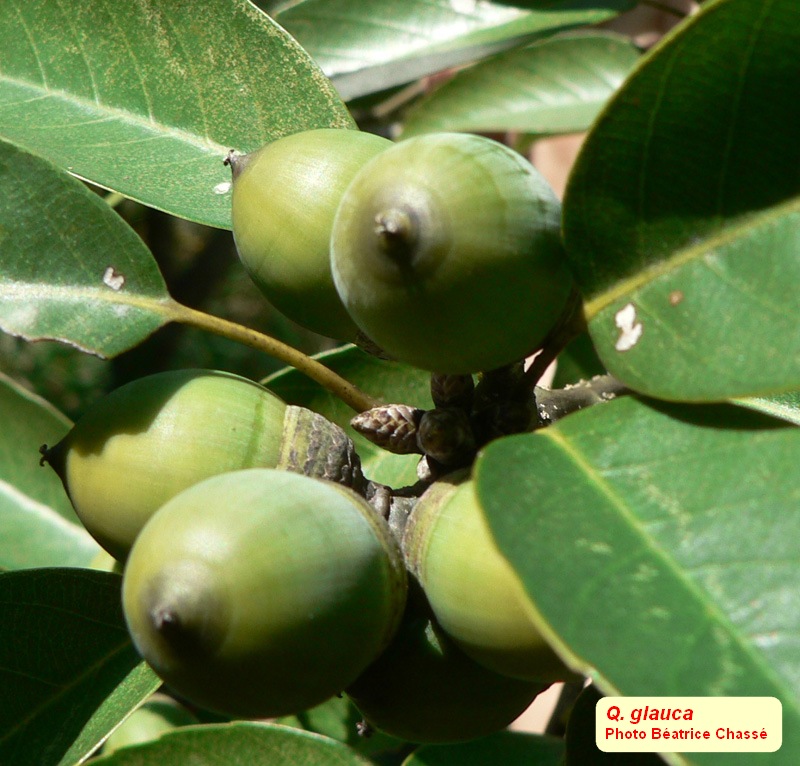| Quercus glauca | |
| Author | Thunb. 1784 Syst. Veg. ed. 14 858 |
| Synonyms | Cyclobalanopsis
glauca (Thunb.) Oerst. 1867 Cyclobalanopsis glauca var. kuyuensis (Liao) Liao Cyclobalanopsis repandifolia (Liao) Liao 1976 amamiana Hatus. 1951 blakei var. vaniotii (H.LÚv.) Chun 1928 glauca var. annulata (Smith) A.Camus 1936 glauca subsp euglauca A.Camus glauca var. kuyuensis J.C.Liao globosa (Lin & Liu) Liao 1970 ichangensis Nakai ex A.Camus 1938 lacera Blume 1851 longipes Hu 1951, nom. illeg. not Stev. 1857 lotungensis Chun & Ko 1958 matasii Siebold 1830 phullata Buch.- Ham. ex D.Don 1825 repandifolia Liao 1968 sasakii Kaneh. 1916 tranninhensis Hick. & A.Camus 1921 (A. Camus n░ 48) vaniotii H.LÚv. 1913 |
| Local names | Ara-kasi ; blue Japanese oak ; |
| Range | Japan; Taiwan; China (Anhui, Fujian, Gansu, Guangdong, Guangxi, Guizhou, Henan, Hubei, Hunan, Jiangsu, Jiangxi, Shaanxi, Sichuan, Taiwan, Xizang, Yunnan, Zhejiang); Korea; North India; Myanmar; Indo-china; in forests from 100 m to 2600 m; introduced in Europe in 1804; |
| Growth habit | to 10 m tall usually; often shrubby, but may reach 15 m and more (20 m in Taiwan, trunk to 45 cm in diameter); crown ovoid at first, becoming domed; |
| Leaves | 6-13 x 2.5-5 cm; evergreen; oboval to oblong-elliptic; thick, leathery; entire, slightly serrate in apical 1/2; apex acuminate to caudate; base rounded or broadly cuneate; shiny dark green adaxially; blue green, pubescent beneath but glabrescent; young leaves pubescent, variable in color : brown, bronze, purple or green; 9-13 parallel, slightly curved, prominent beneath vein pairs; tertiary veins inconspicuous beneath; petiole 1-3 cm, yellow; |
| Flowers | male flowers on catkins shorter than the leaves, drooping, with long bracts, 4-5 stamens; female inflorescences short, bearing 2-4 flowers; |
| Fruits | acorn ovoid, oblong-ovoid or ellipsoid, 1-1.6 cm long, 0.9-1.4 cm in diameter; single or to 3; enclosed 1/3 or 1/2 by cup; cup with 5-6 concentric rings, slightly hairy to hairless, 1-1.3 cm in diameter; maturing in 1 year; |
|
Bark, twigs and |
bark blackish brown, smooth at first aging furrowed and rough; young twigs glabrescent, thick, stiff, dark olive green, with pale lenticels; buds 5-7 in clusters, ovoid to globose, rusty brown, 3-8 mm, with some hairy scales basally; |
| Hardiness zone, habitat | zone 7-8; all types of soils except calcareous ones; slow growing; |
| Miscellaneous | -- A. Camus : n░
47; -- Sub-genus Cerris, Section Cyclobalanopsis; -- Section Glauca, sub-section Glaucae (Menitsky); -- This taxon is an element of a large complex, wide-spreading, described under many uncertain species names (such as Q.globosa (Lin & Liu) J.C.Liao 1970 = Cyclobalanopsis globosa T.P. Lin & T.S. Liu 1965, in Taiwan); |
| Subspecies and varieties |
-- Q.annulata Smith in Rees 1819 Cycl.
29: 22 1819 -- f. gracilis Rehd. & Wils. 1916 |
| Pictures |
|












